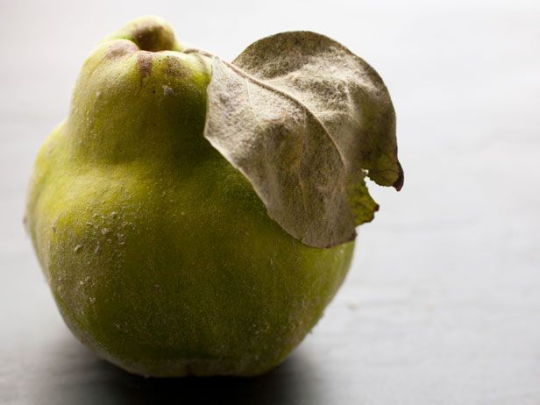What Are Quinces and What Are We Supposed to Do with Them?

What Are Quinces
Distantly related to apples and pears, quinces are a fall fruit you might not be as familiar with. They’re shaped like fuzzy, knobby Bartletts, with a lemon-yellow hue when ripe. But unlike apples and pears, quinces are not a fruit you can eat raw. If you try biting into one, you’ll be sorely disappointed. The flesh is spongy and hard, and the taste is supremely sour. But if you stopped there, you’d be missing out. The quince’s charm is unlocked through cooking.
Less popular in the United States, quinces have been all the rage in Asia and the Mediterranean for the past 4,000 years. It’s a fruit with both culinary and mythological history. In fact, the quince is the “golden apple” that started the Trojan War and may even have been the apple in the Garden of Eden. Despite these associations, ancient Greeks prized the quince as a symbol of happiness, fertility and love.
While quinces aren’t good for eating out of hand, the perfume they release as they ripen — with notes of guava, vanilla and pineapple — hints at the magic within. To cook a quince is to transform it: Simmering turns the flesh tender and pink, and the tartness is tempered by sweetness.
Health Benefits of Quinces
On the nutrition front, quinces are an excellent source of vitamin C and have a smattering of other vitamins and minerals. In folk medicine, quince has been used as a stomach medicine to quell diarrhea and gas.
How to Choose and Cut Quinces
Quinces are ripe when they turn golden yellow and release a sweet perfume. They’re super-hard, so take care when you’re cutting them. Use a sharp knife and a secure cutting board (put a damp towel under the board to keep it in place) and first cut the quince in half, then quarter and core.
Cooking with Quinces
There are several ways to use quince, depending on region. In Spain, quince is enjoyed as dulce de membrillo, a reddish paste that’s the perfect foil for the nuttiness of Manchego. In Moroccan and Persian cuisines, quinces are cooked along with meat into tagines and khoresh. Quinces have a high pectin content, which makes them perfect for cooking down into jam or jelly. And they can also be turned into dessert wine or brandy.
Try a traditional Persian quince stew, such as this one from blogger Ahu Eats.
If you poach quinces in a sugar bath, you can use the remaining syrup to make a delightful quince soda or cocktail.
Kerri-Ann is a registered dietitian who writes on food and health trends. Find more of her work at kerriannjennings.com or follow her on Twitter or Facebook.
More from Food Network:
Spice Up Weeknight Dinners With These Healthy Recipes
12 Foods Nutritionists Say They Won’t Eat
